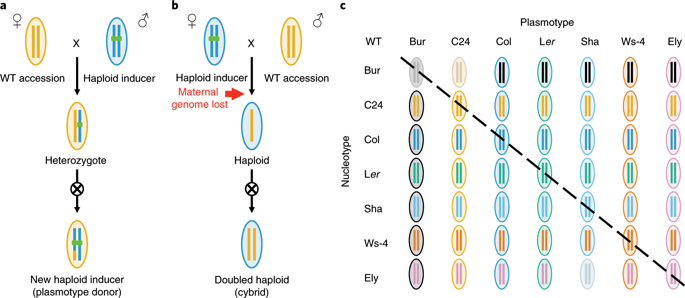Nature Plants ( IF 15.8 ) Pub Date : 2020-01-13 , DOI: 10.1038/s41477-019-0575-9 Pádraic J Flood 1, 2, 3 , Tom P J M Theeuwen 1 , Korbinian Schneeberger 3 , Paul Keizer 4 , Willem Kruijer 4 , Edouard Severing 3 , Evangelos Kouklas 1 , Jos A Hageman 4 , Raúl Wijfjes 5 , Vanesa Calvo-Baltanas 1 , Frank F M Becker 1 , Sabine K Schnabel 4 , Leo A J Willems 6 , Wilco Ligterink 6 , Jeroen van Arkel 7 , Roland Mumm 7 , José M Gualberto 8 , Linda Savage 9 , David M Kramer 9 , Joost J B Keurentjes 1 , Fred van Eeuwijk 4 , Maarten Koornneef 1, 3 , Jeremy Harbinson 2 , Mark G M Aarts 1 , Erik Wijnker 1

|
Assessment of the impact of variation in chloroplast and mitochondrial DNA (collectively termed the plasmotype) on plant phenotypes is challenging due to the difficulty in separating their effect from nuclear-derived variation (the nucleotype). Haploid-inducer lines can be used as efficient plasmotype donors to generate new plasmotype–nucleotype combinations (cybrids)1. We generated a panel comprising all possible cybrids of seven Arabidopsis thaliana accessions and extensively phenotyped these lines for 1,859 phenotypes under both stable and fluctuating conditions. We show that natural variation in the plasmotype results in both additive and epistatic effects across all phenotypic categories. Plasmotypes that induce more additive phenotypic changes also cause more epistatic effects, suggesting a possible common basis for both additive and epistatic effects. On average, epistatic interactions explained twice as much of the variance in phenotypes as additive plasmotype effects. The impact of plasmotypic variation was also more pronounced under fluctuating and stressful environmental conditions. Thus, the phenotypic impact of variation in plasmotypes is the outcome of multi-level nucleotype–plasmotype–environment interactions and, as such, the plasmotype is likely to serve as a reservoir of variation that is predominantly exposed under certain conditions. The production of cybrids using haploid inducers is a rapid and precise method for assessment of the phenotypic effects of natural variation in organellar genomes. It will facilitate efficient screening of unique nucleotype–plasmotype combinations to both improve our understanding of natural variation in these combinations and identify favourable combinations to enhance plant performance.
中文翻译:

互惠杂种揭示细胞器基因组如何影响植物表型
由于难以将它们的影响与核衍生变异(核型)区分开来,评估叶绿体和线粒体 DNA(统称为质体型)对植物表型的影响具有挑战性。单倍体诱导系可用作有效的等离子型供体,以产生新的等离子型-核型组合(杂交体)1。我们生成了一个小组,其中包括七种拟南芥的所有可能的杂种加入并在稳定和波动条件下对这些品系进行了广泛的表型分析,共有 1,859 个表型。我们表明,等离子型的自然变异导致所有表型类别的加性和上位效应。诱导更多加性表型变化的血浆型也会引起更多的上位效应,这表明加性和上位效应可能具有共同基础。平均而言,上位相互作用解释的表型差异是加性等离子型效应的两倍。在波动和压力大的环境条件下,血浆型变异的影响也更为明显。因此,等离子型变异的表型影响是多级核型-等离子型-环境相互作用的结果,因此,等离子型很可能充当在某些条件下主要暴露的变异库。使用单倍体诱导物生产杂种是一种快速而精确的方法,用于评估细胞器基因组中自然变异的表型效应。它将有助于有效筛选独特的核型-等离子体型组合,以提高我们对这些组合中自然变异的理解,并确定有利的组合以提高植物性能。











































 京公网安备 11010802027423号
京公网安备 11010802027423号